Make America Gay Again the Earth Global Warming Animation
Berkeley World, a California-based not-profit enquiry organisation, has been preparing contained analyses of global hateful temperature changes since 2013. The following is our report on global mean temperature during 2020.
We conclude that 2020 was nominally the second warmest yr on Earth since 1850. Our approximate of the global mean temperature in 2020 was slightly colder than 2016, but warmer than every other year that has been straight measured. However, the difference between 2020 and 2016 was only 0.022 °C. This is smaller than the 0.045 °C incertitude on our ability to measure the global average temperature in 2020. This means that 2020 and 2016 could also exist regarded equally effectively tied.
Year-to-year rankings are likely to reflect short-term natural variability, simply the overall pattern remains consequent with a long-term trend towards global warming.
In improver, 2020 was notable for:
- A new record for the warmest almanac land-average of any year since 1850
- Record-shattering warmth in Siberia and Northern Asia
- The emergence of a moderate La Niña that reduced global mean temperatures in the latter half of 2020 and is likely to proceed 2021 cooler than other contempo years
Annual Temperature Anomaly

The global mean temperature in 2020 is estimated to take been ane.27 °C (ii.29 °F) above the boilerplate temperature of the late 19th century, from 1850-1900, a period often used as a pre-industrial baseline for global temperature targets. This is ~0.02 °C cooler than in 2016, and ~0.02 °C warmer than 2019. As a result, 2020 is nominally the 2nd warmest twelvemonth to have been straight observed, though the three warmest years are all tightly clustered together relative to the incertitude in these measurements.
This temperature in 2020 is equivalent to 0.94 °C (1.69 °F) in a higher place the 1951-1980 average which is oftentimes used equally a reference menses for comparing global climate analyses.
The last six years have included all of the half dozen warmest years directly observed.
| Yr | Rank | Warming in °C | Warming in °F |
| 2020 | 2 | 1.27 ± 0.04 | 2.29 ± 0.08 |
| 2019 | 3 | 1.25 ± 0.05 | two.24 ± 0.08 |
| 2018 | 6 | one.11 ± 0.04 | 2.00 ± 0.08 |
| 2017 | four | 1.xviii ± 0.05 | ii.12 ± 0.08 |
| 2016 | i | 1.29 ± 0.05 | 2.33 ± 0.08 |
| 2015 | 5 | 1.fifteen ± 0.04 | 2.08 ± 0.08 |
| 2014 | 8 | one.01 ± 0.05 | ane.82 ± 0.08 |
| 2013 | 13 | 0.95 ± 0.05 | one.70 ± 0.08 |
| 2012 | sixteen | 0.92 ± 0.04 | 1.65 ± 0.08 |
| 2011 | 18 | 0.91 ± 0.04 | 1.64 ± 0.08 |
| 2010 | 7 | 1.03 ± 0.04 | 1.85 ± 0.08 |
The temperature uncertainties tin be visualized using the schematic below where each year's temperature estimate is represented past a distribution reflecting its uncertainty. In the analysis that Berkeley Earth conducts, the dubiousness on the mean temperature is approximately 0.05 °C (0.08 °F) for contempo years. The global mean temperature in 2020 fell squarely between those observed in 2016 & 2019. The 3 almost recent years have substantially overlapping uncertainties, leading to an associated uncertainty in the true relative rankings of these years.

The terminal six years stand out as a period of pregnant warmth well to a higher place all previous years since 1850. This reflects the long-term trend towards global warming. Though 2020 is nominally slightly cooler than 2016, its overall temperature remains consistent with the long-term warming tendency.
In addition to long-term warming, private years are as well affected by interannual variations in weather. Both 2015 and 2016 were warmed past an extreme El Niño event that peaked in Nov/Dec of 2015 and was reported by NOAA as substantially tied for the strongest El Niño ever observed. That exceptional El Niño boosted global hateful temperatures in 2015 and 2016. By contrast, 2020 began with neutral weather and finished with a moderate La Niña. This La Niña would be expected to somewhat reduce temperatures in 2020, and is probable to have a larger impact on 2021. Internal weather variability, such as El Niño and La Niña, generate year-to-year variations in temperatures that occur in improver to the long-term warming trend.
Land Boilerplate Temperature in 2020
Though 2020 was nominally only the 2nd warmest year, this was affected in meaning role by the cooling result of La Niña in the oceans. Over state, 2020 was unambiguously the warmest twelvemonth that has been directly observed.
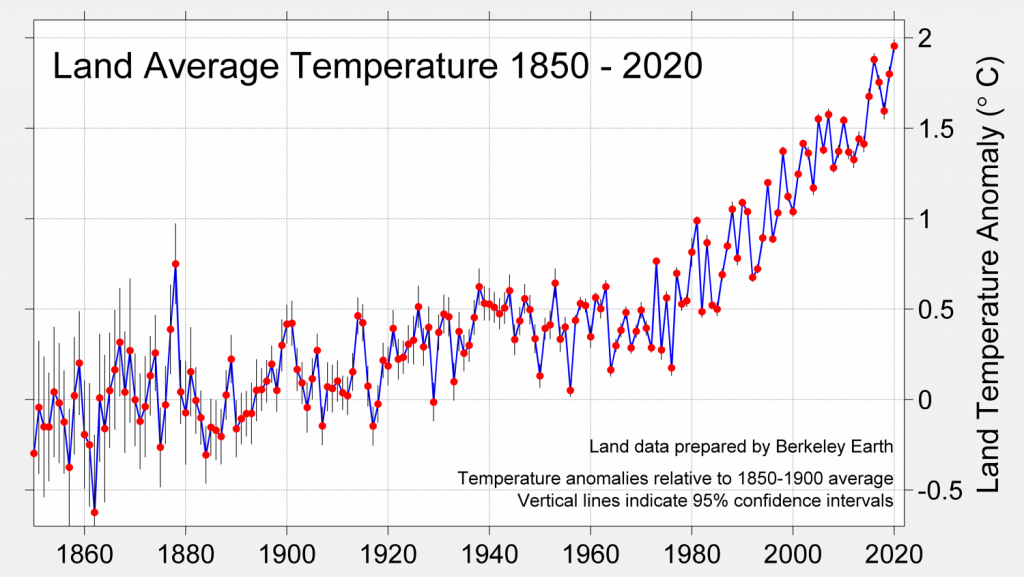
In 2020, the land average temperature was i.96 ± 0.04 °C above the boilerplate temperature from 1850 to 1900. This unambiguously exceeds the previous record of 1.88 °C observed in 2016. As discussed below, many territories saw record warm annual averages in 2020, with conditions in Northern Asia existence particularly extreme.
Temperature Distribution in 2020
The following map shows how local temperatures in 2020 have increased relative to the average temperature in 1951-1980.
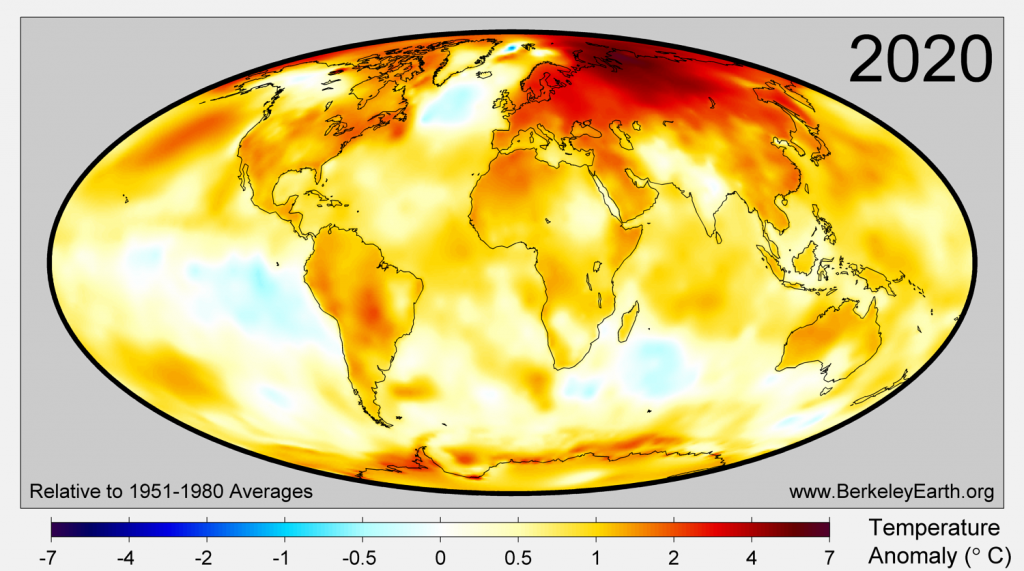
Every bit can be expected from the global warming caused by greenhouse gases, the temperature increase over the globe is broadly distributed, affecting nearly all land and bounding main areas. In 2020, 87% of the World's surface was significantly warmer than the average temperature during 1951-1980, 12% was of a similar temperature, and but i.3% was significantly colder.
We estimate that ten.ii% of the Earth's surface gear up a new local record for the warmest annual average. In 2020, no places on Globe experienced a record common cold annual average.
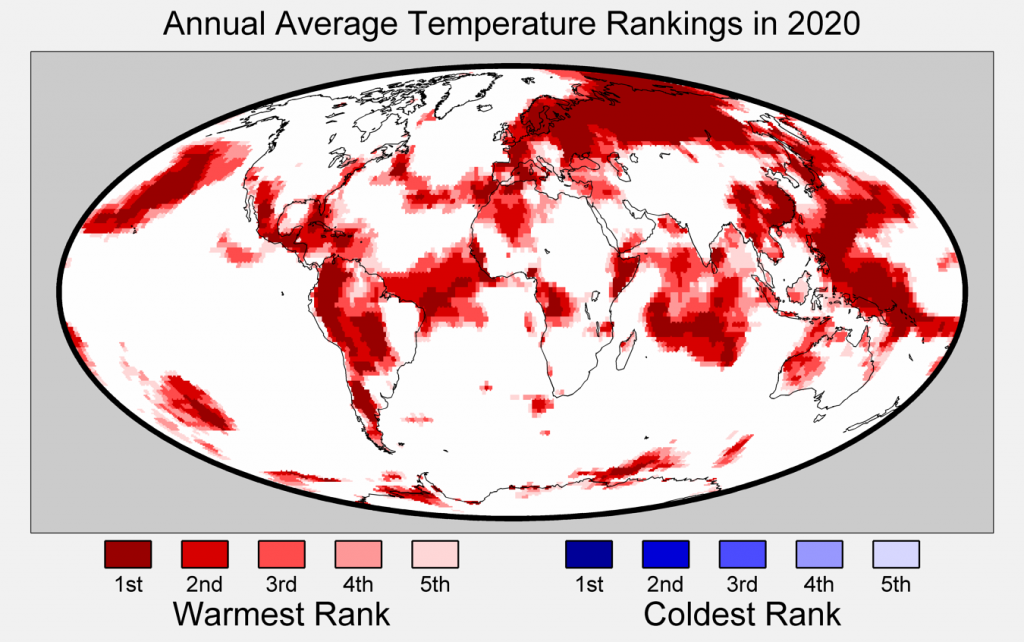
State areas generally testify more than twice equally much warming as the ocean. When compared to the 1850-1900 averages, the country boilerplate in 2020 has increased one.96 ± 0.04 °C (3.53 ± 0.08 °F) and the ocean surface temperature, excluding sea ice regions, has increased 0.82 ± 0.06 °C (1.48 ± 0.11 °F). As already noted, 2020 was the warmest year on land. For the ocean surface, we find that 2020 nominally ranks as the fourthursday warmest year. Yet, the differences between the ist, 2nd, threerd and 4th warmest years in the body of water are small compared to the measurement uncertainty, pregnant they are all hard to distinguish. The following figure shows land and ocean temperature changes relative to the average from 1850 to 1900. The tendency for country averages to increment more quickly than body of water averages is clearly visible.

Every bit in other recent years, 2020 also demonstrated very stiff warming over the Arctic that significantly exceeds the Earth's mean rate of warming. This is consequent with the process known as Arctic distension. By melting sea ice and decreasing snow cover, warming in the Arctic regions causes more than sunlight to exist absorbed, which allows for yet more warming. 2020 was the 2nd warmest twelvemonth in the Arctic.
Both the tendency for state to warm faster than ocean and the higher rate of warming over the Arctic are expected based on our agreement of how increases in greenhouse gas concentrations volition impact the Globe's climate. Every bit has been reported by the Global Carbon Project and other observers, 2020 saw a new record for the level of carbon dioxide in the atmosphere. This is due to the continued aggregating of carbon dioxide from human activities. However, the almanac corporeality of carbon dioxide emitted in 2020 was vi.7% lower than 2019 as a consequence of the COVID-xix pandemic.
Development of La Niña
The emergence of the La Niña conditions phenomenon in the latter one-half of 2020 had a substantial influence on temperatures in 2020, and is expected to have an fifty-fifty larger impact on 2021.
La Niña is characterized by the emergence of a large area of relatively cool water in the western equatorial Pacific, equally can clearly be seen in this map of average temperatures from September to December. In add-on to the immediate cooling in the Pacific, La Niña tin can take far-reaching effects on global circulation and atmospheric condition patterns. This disruption of weather patterns tends to be associated with an extended menses of somewhat reduced global boilerplate temperatures that can last for months beyond the peak of the La Niña in the Pacific.

Notably, the monthly time series of ocean average temperatures has shifted sharply lower during the terminal four months as La Niña has adult. Without this cooling, more than than 0.2 °C during the final few months, global average temperatures in 2020 would have nominally surpassed the temperatures reported in 2016.
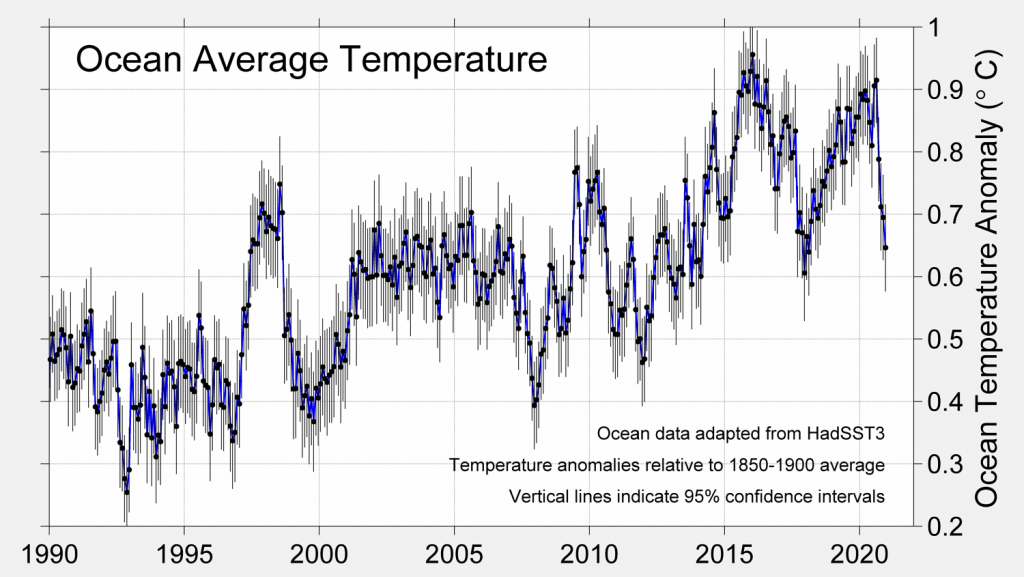
National Average Temperature
Though the focus of our work is on global and regional climate analysis, it is besides possible to apply our data to guess national temperature trends.
In Berkeley Globe's estimation, 2020 had the warmest annual average since instrumental records began in the post-obit 45 countries:
Andorra, Antigua and Barbuda, Argentine republic, Belarus, Belgium, Belize, Bolivia, Colombia, Cuba, Djibouti, Commonwealth of dominica, Estonia, Federated States of Micronesia, Fiji, Finland, France, The Republic of the gambia, Guatemala, Republic of guinea-bissau, Honduras, Jamaica, Japan, Republic of latvia, Republic of lithuania, Luxembourg, Republic of the maldives, Marshall Islands, United mexican states, Moldova, Nauru, Peru, Democracy of the Congo, Russia, Saint Kitts and Nevis, Senegal, Seychelles, Sierra Leone, Solomon Islands, Somalia, Sweden, Taiwan, Tuvalu, Ukraine, Vanuatu, and Venezuela
In addition, it was also the warmest year thus far observed for both the continental averages of Europe and Asia, and effectively tied for the warmest in South America.
The following chart provides a summary of the warming that countries experienced in 2020 relative 1951 to 1980 averages.

These estimates for the changes in national almanac average temperatures are derived from our global temperature fields. Due to uncertainties in the assay and the limits of our spatial resolution some national average estimates may differ slightly from the values reported past national weather agencies.
Temperatures in Russian federation
The weather conditions in Russia during 2020 were particularly extreme and worthy of extra attention. During 2020, the average temperature in Russia was well-nigh four °C (vii °F) above the pre-industrial boilerplate. This broke the previous record for warmest yr in Russian federation by a staggering 1.2 °C (ii.2 °F).

It is extremely unusual for large-calibration almanac-average temperature records to be broken by such a large margin. In this instance, much of the effect tin exist associated with boggling warm weather patterns over Siberia. Inside Russia'due south fundamental Siberian Federal Commune, the average temperature in 2020 was nearly five °C (9 °F) above the pre-industrial norm, and the warmest locations in this region averaged more than than vii °C (12.5 °F) higher up normal.

The extraordinary warmth in Siberia led to permafrost thawing and acquired unanticipated disruptions. With anomalous warmth extending into the areas of the Arctic Bounding main adjacent to Siberia, it also led to a record-smashing 3 and a half months of traversable open ocean along the Northern Sea Route (Northeast Passage) within the Arctic. Prior to the year 2005, open up ocean passages in the Arctic rarely formed.
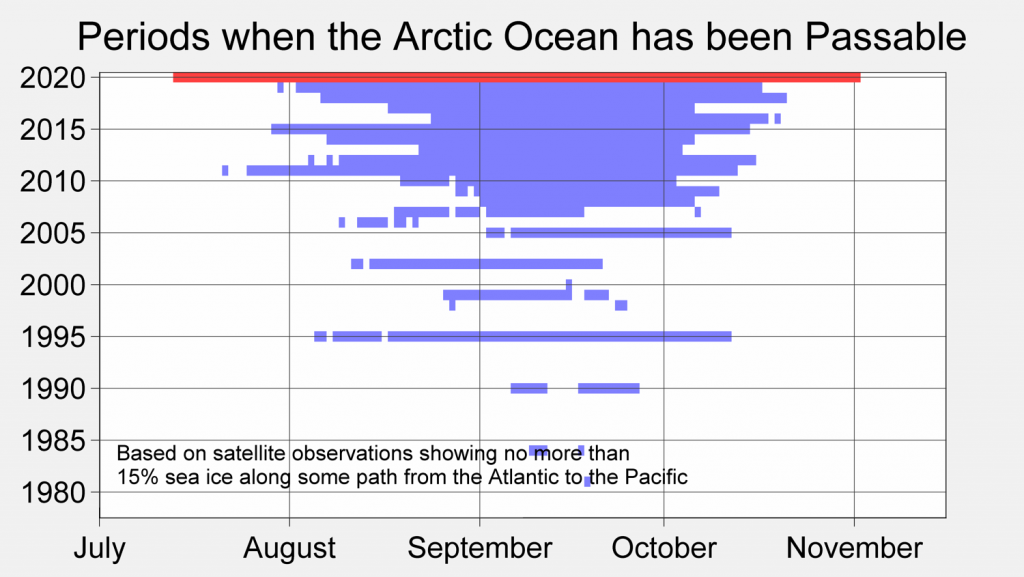
These effects are related to the phenomenon known equally Chill Amplification, whereby changes in snowfall and sea ice cover cause the Arctic to warm faster than other regions of the globe. All the same, even so, the weather pattern observed in 2020 was more severe than generally expected. The level of warmth observed this yr in Siberia is not expected to go common until the latter half of the century.
Monthly Temperature Patterns
Every calendar month in 2020 was at to the lowest degree 1.05 °C (1.9 °F) warmer than the 1850 to 1900 average. Six months (April, May, June, July, September, and Nov) set a new monthly tape for the globe. Prior to October, no month ranked lower than 4th; however, October ranked 5th and December ranked seventh. These low rankings in October and December are partially due to cooling associated with La Niña.


Long-term Trend
Though it is interesting to understand the characteristics of individual years, global warming is ultimately about the long-term evolution of Earth'due south climate. The post-obit chart shows a x- year moving average of the Earth'south surface temperature, plotted relative to the average temperature from 1850-1900.

Since 1980, the overall trend is +0.19 °C/decade (+0.34 °F/decade) and has inverse little during this period. By continuing this trend, we tin can make a crude guess of how the about-future climate may develop if the forces driving global warming continue at their nowadays rate.
Every bit shown in the chart, several contempo years accept had temperatures more than than 1 °C (1.eight °F) above the average temperature from 1850-1900, often used equally an gauge of the pre-industrial climate. The Paris Agreement on Climate Change aims to keep global temperature rise to well below two °C (3.6 °F) and encourages parties to strive for warming of no more than than 1.5 °C (2.7 °F). At the current rate of progression, the increase in Earth's long-term average temperature volition achieve ane.5 °C (2.7 °F) above the 1850-1900 boilerplate by around 2035 and 2 °C (3.six °F) volition be reached around 2065. The increasing abundance of greenhouse gases in the atmosphere due to human activities is the direct cause of this recent global warming. If the Paris Agreement's goal of no more than than ii °C (three.6 °F) warming is to exist reached, significant progress towards reducing greenhouse gas emissions needs to be made before long.
Prediction for 2021
Based on historical variability and electric current conditions, information technology is possible to roughly estimate what global hateful temperature might exist expected in 2021. Our current estimate is that 2021 is likely to be substantially cooler than 2020. The reason for the expectation is principally due to the ongoing La Niña result. La Niña events are associated with widespread cooling in the central Pacific Ocean, and generally depress global average temperatures for several months following their occurrence. The swings from El Niño to La Niña and back again, are the ascendant source of interannual variability in the global temperature record.
Information technology is well-nigh certain that 2021 volition remain within the top-x warmest years; however, there is a l% gamble that 2021 will rank no higher than 5th warmest twelvemonth. There is only a remote gamble (a few per centum) that 2021 will be warmer than 2016. More likely, 2021 will be ane of the coolest years of this decade.

Though 2021 is expected to be relatively absurd, that does not hateful that global warming has stopped. Rather, it is just a minor fluctuation that may provide the earth one year of slightly less exceptional weather condition before weather conditions swing back towards the long-term warming trend.
Comparisons with Other Groups
When preparing our yr-end reports, Berkeley Earth traditionally compares our global mean temperature analysis to the results of five other groups that besides written report global hateful surface temperature. The following chart compares Berkeley Earth's analysis of global hateful temperature to that of the NASA's GISTEMP, NOAA's GlobalTemp, the UK'due south HadCRUT, Cowtan & Way, and ECMWF's reanalysis. All of these groups produce a similar agreement of contempo climate change. As of the time this document was being finalized, 2020 values for Cowtan & Way were non available.
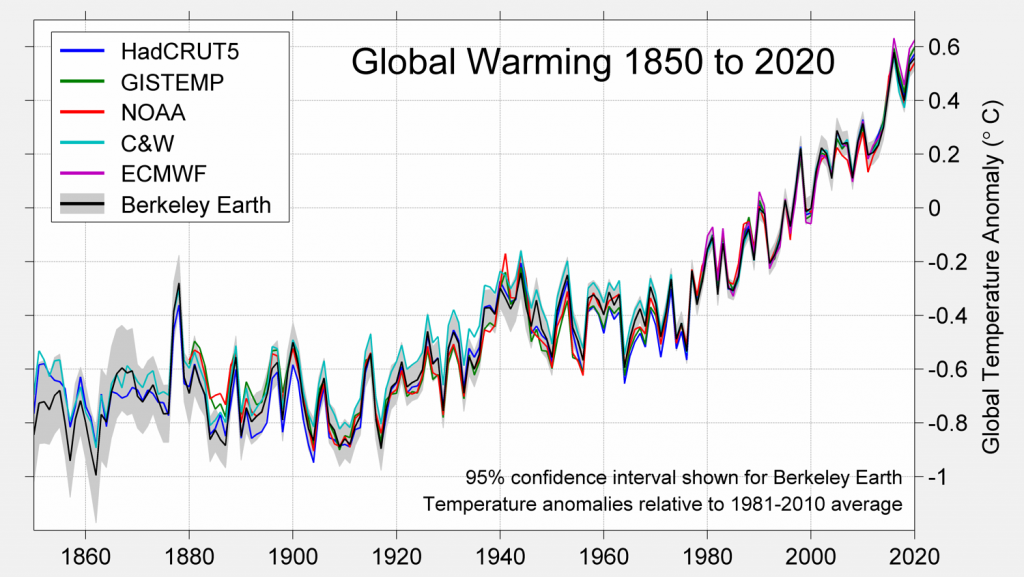
Of these groups, NOAA, HadCRUT, and ECMWF concur with Berkeley Earth that 2020 was nominally the 2nd warmest year, though Berkeley Earth's margin of difference between 2016 and 2020 is really the largest of the four. GISTEMP, places 2020 equally the warmest year, exceeding 2016 by a minuscule 0.004 °C. All of the groups agree that the deviation between 2016 and 2020 is inside the margin of uncertainty on our ability to measure global mean temperature.
The slight disagreement in the ranking reflects both the uncertainty in these estimations and the differences in how various inquiry programs look at the Earth. Each uses a somewhat different choice of source information and different methods of interpolation and correcting for measurement errors. Some methods are more limited than others. For instance, NOAA omits about of the polar regions when estimating mean temperature changes. As a result, it is non surprising to encounter small disagreements amongst the groups.
Methodology
In reconstructing the changes in global hateful temperature since 1850, Berkeley Earth has examined 21 meg monthly-boilerplate temperature observations from 50,564 weather stations. Of these 19,460 stations and 198,000 monthly averages are available for 2020.
The weather condition station information is combined with sea surface temperature data from the UK Met Office's Hadley Heart (HadSST). This body of water data is based on 411 million measurements nerveless past ships and buoys, including nineteen meg observations obtained in 2020. We reprocess and interpolate the HadSST data to provide a more complete picture of the oceans. After combining the body of water information with our land data, nosotros make it at a global pic of climatic change since 1850.
Uncertainties arise primarily from the incomplete spatial coverage of historical atmospheric condition observations, from noise in measurement devices, and from biases introduced due to systematic changes in measurement technologies and methods. The full uncertainty is much less than the long-term changes in climate during the last 170 years.
This report is based on such weather observations as had been recorded into global athenaeum equally of early Jan 2021. It is common for additional observations to exist added to athenaeum after some filibuster. Consequently, temperature analysis calculations can be subject field to revisions as new data becomes available. Such revisions are typically quite small and are considered unlikely to modify the qualitative conclusions presented in this study.
Copyright
This report was prepared past Berkeley Globe. The contents of this study, including all images may be reused under the terms of the Artistic Commons BY-4.0 copyright license for any purpose and in any forum, consistent with the terms of that license.
Members of the news media may also use the materials in this study for any news reporting purpose provided that Berkeley World is properly acknowledged, without concern for whether or not the CC BY-four.0 license is followed.
Information
Updated data files will appear at our information page, and are updated monthly.
In particular, monthly and annual time serial are available.
Source: https://berkeleyearth.org/global-temperature-report-for-2020/
0 Response to "Make America Gay Again the Earth Global Warming Animation"
Postar um comentário